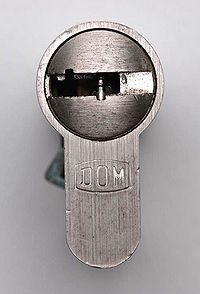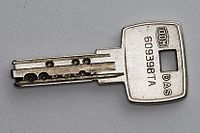Dimple: Difference between revisions
No edit summary |
mNo edit summary |
||
| Line 2: | Line 2: | ||
[[File:DOM_DAS_cylinder.jpg|thumb|right|text-top|200px|A [[DOM]] dimple lock.]] | [[File:DOM_DAS_cylinder.jpg|thumb|right|text-top|200px|A [[DOM]] dimple lock.]] | ||
A '''dimple''' lock is a [[pin-tumbler]]-based [[lock]] design that uses flat side of the key blade as a bitting area. Cuts on the bitting area resemble dimples, hence the name. This contrasts traditional pin-tumblers that use the edge of the blade as the primary bitting area. Most dimple locks orient the keyway of the lock perpendicular to the pin stacks and allow the [[key]] to be inserted in any orientation. | A '''dimple''' lock is a [[pin-tumbler]]-based [[lock]] design that uses flat side of the key blade as a bitting area. Cuts on the bitting area resemble dimples, hence the name. This contrasts traditional pin-tumblers that use the edge of the blade as the primary bitting area. Most dimple locks orient the keyway of the lock perpendicular to the pin stacks and allow the [[key]] to be inserted in any orientation. | ||
| Line 22: | Line 21: | ||
Additional passive and active locking mechanisms are also common, such as [[sidebar]]s and moving elements within the key itself. | Additional passive and active locking mechanisms are also common, such as [[sidebar]]s and moving elements within the key itself. | ||
<br clear=all> | |||
== Vulnerabilities == | == Vulnerabilities == | ||
Revision as of 16:26, 10 September 2009
Dimple

A dimple lock is a pin-tumbler-based lock design that uses flat side of the key blade as a bitting area. Cuts on the bitting area resemble dimples, hence the name. This contrasts traditional pin-tumblers that use the edge of the blade as the primary bitting area. Most dimple locks orient the keyway of the lock perpendicular to the pin stacks and allow the key to be inserted in any orientation.
Dimple locks are used in a wide variety of applications, and may vary from low to high security. A dimple lock is not more secure when compared to traditional pin tumbler locks, but the untraditional nature of the key makes many dimple locks appear sophisticated. Some of the most notable dimple lock manufacturers are KABA, Mul-T-Lock, DOM, LIPS, and KESO.
History
Add to me!
Principles of operation

Traditional dimple locks are functionally equivalent to pin-tumblers. The only difference is the orientation of the keyway and the location and style of the bitting cuts on the key blade. More advanced dimple locks use various high-security features like key profiling, side pins, telescoping pins, and axial rotation.
Additional passive and active locking mechanisms are also common, such as sidebars and moving elements within the key itself.
Vulnerabilities
Dimple locks are vulnerable to all of the same attacks as traditional pin-tumbler locks:
Note
- Pick guns have limited effectiveness against dimple locks because of the poor range of motion allowed in the dimple keyway.
References
See also
| This article is a stub. You can help Lockwiki by expanding it. |
